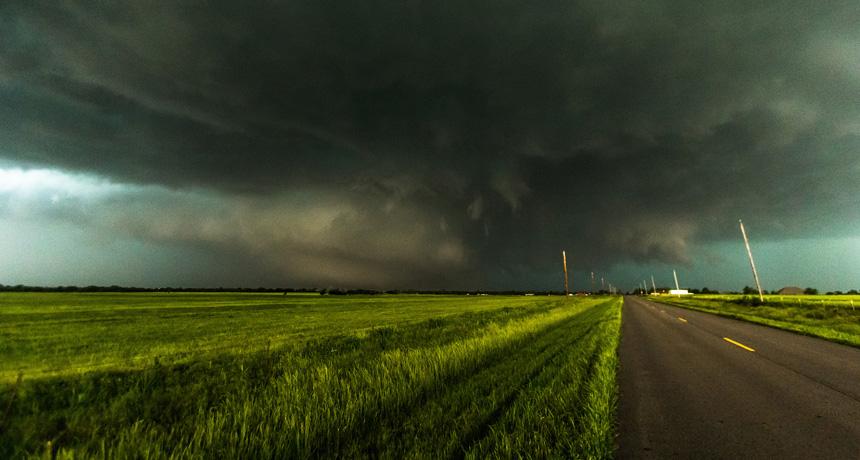Twisters: Can warning people too early backfire?
Give people too much warning of a coming tornado and they might try to flee instead of taking cover

Too many people tried to flee, not seek shelter, when they learned that this — the widest tornado ever recorded — was heading their way. Even earlier tornado warnings might prompt still more people to take such unwise risks.
Daniel Rodriguez/Flickr (CC BY 2.0)
Giving people a longer warning about the expected path of incoming severe weather — such as tornadoes — sounds like a great idea. But people don’t always use the extra time to act wisely, new research shows. Sometimes they do the opposite.
And that worries scientists.
The National Oceanic and Atmospheric Administration’s Severe Storms Laboratory is developing a new alert. Called Warn-on-Forecast, it one day could provide tornado warnings an hour or more before a twister hits. That would be more than 45 minutes longer than the 14-minute warning that is typical today.
Kim Klockow is a meteorologist and behavioral scientist at University Corporation for Atmospheric Research. Her agency is based in Boulder, Colo. Storm forecasters want people to make use of any extra warning time to seek shelter, she says. Unfortunately, many people instead may try to use the extra time to flee. And that could backfire, she and other worry.
Those worries are well-founded. Consider what happened two years ago.
On May 20, 2013, a monster, twister touched down outside Oklahoma City. Over 40 minutes, it traveled a 27.4 kilometer (17 mile) path. As it plowed through Moore, Okla., and other towns, it leveled homes and a school. Dozens of people died. Scientists estimated the tornado’s wind speed at roughly 322 kilometers per hour (200 miles per hour).
Just 11 days later, a new storm threatened the same general area. With the Moore devastation fresh on people’s minds (plus a few local weather reports urging people without basements to head south), thousands of people jumped into their cars. Instead of taking shelter, these people attempted to flee.
In short order, the highways became a congested, chaotic mess. Cars headed south on northbound lanes. Gridlock extended more than 40 kilometers (25 miles) out of the city. Scared residents “just left their houses and headed south,” Klockow says.
But so did the storm. And it was a powerful one. It cut a swath of 4.2 kilometers (2.6 miles), the widest ever recorded. And it left some 13,000 damaged homes in its wake.
While many tornadoes travel northeast, on May 30 this behemoth twister headed south — toward carloads of families. Unable to offer any help, meteorologists looked on in terror. Cars, they knew, offer next to no protection from even a mild tornado, let alone one barreling down with winds nearing 475 kilometers per hour (295 miles per hour). If the storm hit the highway, hundreds could have died.
In the end, that didn’t happen. But it was a very close call.
Says Klockow: “This was possibly the greatest natural disaster that almost was in recent U.S. history.” Indeed, she notes, “We had possibly the worst survival response [to a warning] we’ve ever seen.” And what makes this especially troubling: She notes that it occurred “in the most tornado-savvy part of the country.”
So how might people respond to the new Warn-on-Forecast program? A survey published in 2011 offers one early clue. It suggests that scared homeowners would likely try to drive away. Klockow, who coauthored the study, says her team’s findings reveal that people have an innate desire to flee. This shows they often do not understand the risks of that action.
Meteorologist Lans Rothfusz is one of the scientists behind Warn-on-Forecast. In a September 9 article in Eos, he laid out the challenge of helping the public understand probabilities — the chance that something might occur. Instead of a single alert — one that warns of an impending twister — the new system will estimate the percentage risk that a particular area will be hit. Before NOAA begins issuing its new, longer-range twister predictions, his team argues, meteorologists will need to educate the public on how to use this information.
The good news, Klockow says, is that Warn-on-Forecast is still years away from being fully implemented. So storm forecasters have some time to reach people with those guidelines on how to make safer decisions in the face of a life-threatening storm.
Power Words
(for more about Power Words, click here)
meteorologist Someone who studies weather and climate events.
National Oceanographic and Atmospheric Administration, or NOAA A science agency of the U.S. Department of Commerce. Initially established in 1807 under another name (The Survey of the Coast), this agency focuses on understanding and preserving ocean resources, including fisheries, protecting marine mammals (from seals to whales), studying the seafloor and probing the upper atmosphere.
risk The chance or mathematical likelihood that some bad thing might happen. For instance, exposure to radiation poses a risk of cancer. Risk also can refer to the hazard — peril — itself. For instance: Among cancer risks that the people face are radiation and drinking water tainted with arsenic.
tornado A violently rotating column of air extending from the ground to a thunderstorm above.







